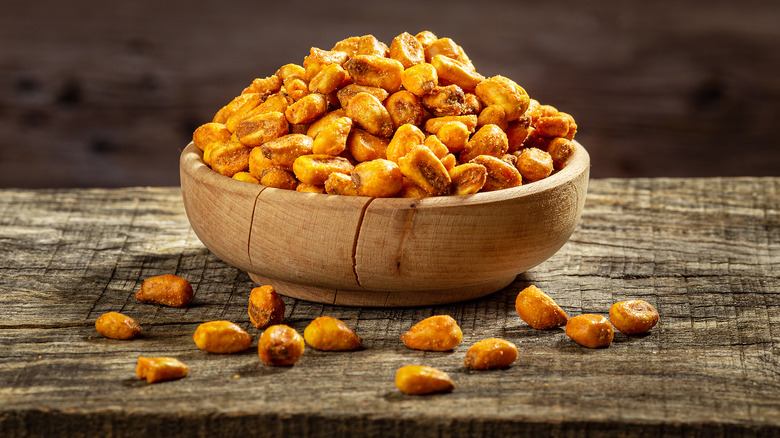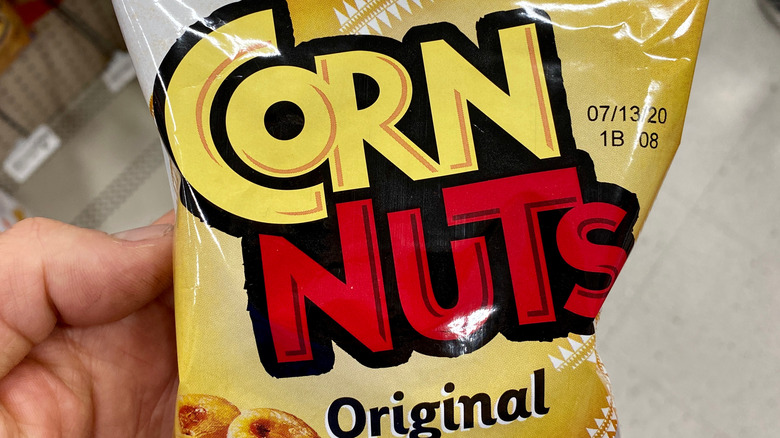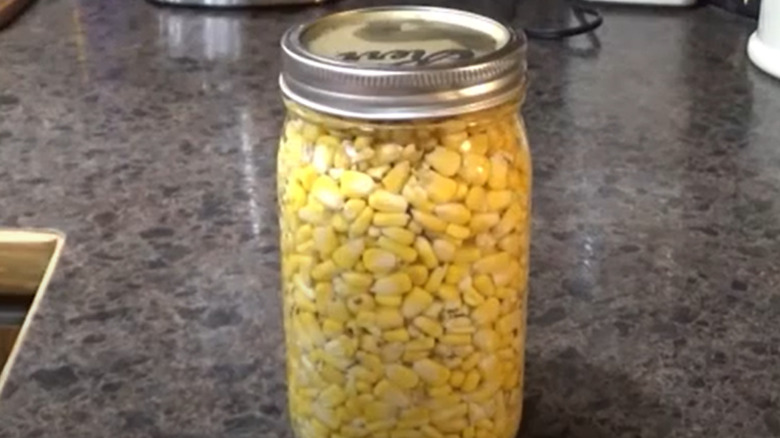What Are Corn Nuts, And Are They Actually Nuts?
Walk down any "nut aisle" in a grocery store, and you're sure to see an enigma of an item: corn nuts. They're usually stashed between the peanuts, pistachios, and trail mixes, which seems to solidify their place as part of the nut family.
But "corn nuts" is quite a confusing name, especially because the snack is made of corn, far from being a nut. Corn nuts are typically fried whole corn kernels, though they can be roasted as well. With a little bit of water — and later, a fryer full of oil — corn kernels transform into the salty snack we all love. Although corn nuts may seem like a modern snack invention, variations of corn nuts have circulated for multiple centuries now. "Corn nuts" may be a bit of a misnomer, but the snack's rich history and the process behind making them are seriously fascinating, especially to anyone who grew up loving the "corny" treat.
How Corn Nuts are made
Although corn nuts used to be made with a Peruvian-American hybrid corn breed that made them giant, they were eventually made with a "smaller" corn variety, maize, to make them more appealing to the masses. Corn nuts may no longer be giant, but their current manufacturing process piques our interest regardless.
To make corn nuts, maize kernels are soaked in water for two to three days to hydrate them; without this step, they'd be too dry to enjoy. Then, some of the soaked kernels are either placed in a fryer and fried in batches, or fried via a conveyor system. Other kernels are roasted in conventional ovens instead of fried, but no matter the method, the exposure to heat during the cooking process gives corn nuts their hard, crunchy texture. Then, the corn nuts ultimately are salted and seasoned to imbue them with those classic flavors you love. If you want to make your own corn nuts, try to use hominy — already-dried maize soaked in lime and rinsed — or giant white corn. No matter whether you buy corn nuts or make them yourself, you'll love crunching on the corn snacks you've been loving since childhood.
The history of corn nuts
Corn nuts have been around for longer than you think — just not with the brand name that's become synonymous with the crunchy corn snack. "Parched corn," a dehydrated snack that's similar to corn nuts, traces back to Native American food traditions centuries ago, but the snack really took on widespread popularity just after Prohibition ended.
With the return of bars in the 1930s came the need to feed hungry bar-goers. Olin Huntington, an Oakland man, came up with the perfect solution: a toasted corn product called Brown Jug, which he sold to bars to give away. Unfortunately, California soon passed a law that forbade giving away food in drinking establishments, forcing Huntington to sell his Brown Jug company to Albert Holloway. It was Holloway who, in 1936, coined the iconic term "corn nuts," inspired by the way that patrons often asked for the snack. After Huntington and Holloway popularized the snack, corn nuts expanded nationally in 1959 and hit store shelves in 1964. Corn nuts' popularity skyrocketed in the '80s and '90s, earning the corn snack a definite place in pop culture. The Corn Nuts company has been sold several times throughout the decades but is currently owned by food giant Hormel. Corn nuts have been a mainstay from the 1930s to the present, and we're thankful we can still experience their "crunch" today.


